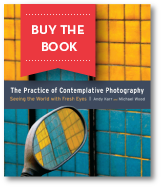Introduction
Photography is the simplest art form. Taking a photograph does not require strong hands, fine motor control, or years of training. To make a picture, all you need to do is point the camera and press a button. (Sometimes you might also need to adjust a few settings.) But photography is not purely mechanical. You also need to know how to look, where to point the camera, and when to press the button. These acts depend on the eye, mind, and heart. All the great photographers used similar skills and equipment to produce dramatically different bodies of artistic work. This shows how important eye, mind, and heart are in photography.
People write a lot about the technical aspects of photography. There are lots of books and articles about different types of equipment, what settings to use in various photographic situations, recipes for composing interesting photos, and of course, “tips and tricks” for achieving dramatic effects.
On the other hand, there is little discussion about how to work with eye, mind, and heart to produce fine images, or how photography can be used to expand your vision and your appreciation of the world. That is why Henri Cartier-Bresson wrote, “Technique is important only insofar as you must master it in order to communicate what you see. . . . In any case, people think far too much about techniques and not enough about seeing.”
The practice of contemplative photography is an approach to the art of photography that emphasizes developing the ability to see.

